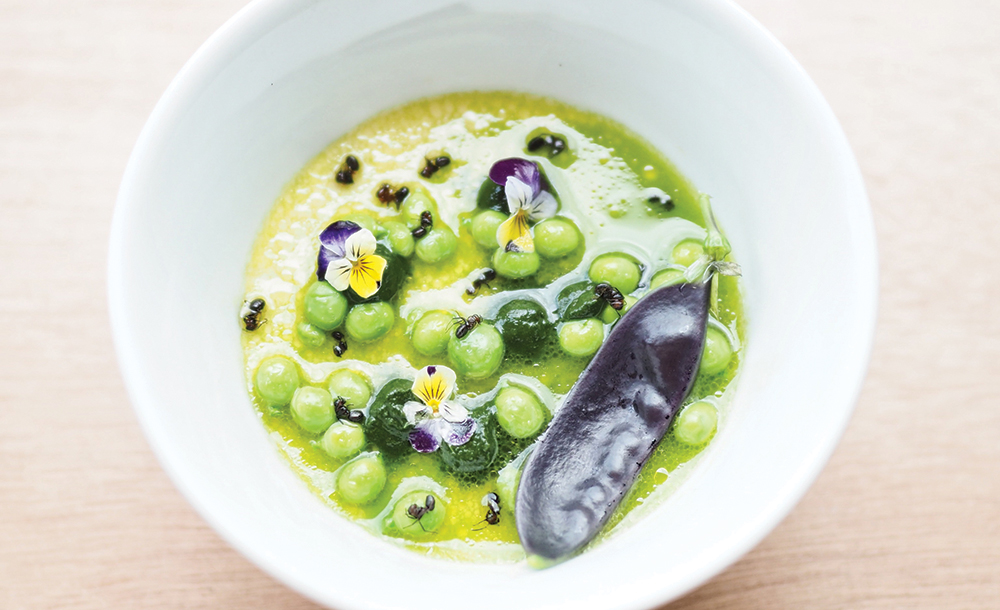Insects have been crawling onto chef Alex Rushmer‘s plate
Some years ago my wife bought me a little booked called Why not eat Insects?. Originally published in 1885, it was sold as just another quirky piece of Victorian eccentricity, an odd and novel essay penned by one Vincent M Holt, a man who (one can only presume) sent out a great many invitations to dine at his table, and received precisely the same number of polite rejections. I imagine him at the head of a grandly laid out table, forlornly looking at the empty seats, before wiping the remnants of the slug soup (he was very loose in defining ‘insect’) entrée from his extravagant moustache.
More recently, another book on entomophagy was gifted to me. On Eating Insects, however, is no Victorian oddity but rather is a far more ambitious publication, this time from the pioneers of the coffee table cookbook, Phaidon. It is a selection of essays, notes, thoughts and recipes from those quirky Scandinavians at the Nordic Food Lab. What is has in common with Holt’s modest manifesto from almost 150 years prior, though, is the nature of its central argument: that there is no reason, other than conditioning, that we reject such a vast number of creatures from our diet. There is nothing stronger than prejudice that prevents us from dining on creatures with four legs, and finding those with six repulsive and unworthy of the table.
This has been at the forefront of my mind recently as I have been designing and cooking a botanical-inspired menu at The Cambridge Distillery in Grantchester. Each dish on the menu is based on the flavours that are present in one of the gins that the distillery produces, and that includes ants. I first tried eating ants in Copenhagen a couple of years ago when I was fortunate enough to snag a reservation at Noma. Head chef René Redzepi has used them as an element in several dishes over the years (most notably as a seasoning on raw shrimp) but when I ate them they were used to flavour a delightful savoury biscuit shaped like a twig. They are completely delicious with a complex citrus flavour similar to sour lemongrass, thanks to the formic acid they produce in their abdomens as a defence mechanism.
‘Ants were used to flavour a delightful savoury biscuit shaped like a twig’
The dish we created in order to highlight their unique flavour is a Japanese set custard flavoured with dashi and then topped with fresh raw peas, juice from the pea pods, a puree of nettles and a single mange tout which is garnished with half a dozen or so red wood ants – several of which I snack on every time I plate up.
Over the years I’ve also eaten crickets and mealworms (the former tasty, the latter not so much) which may sound odd to us, but certainly not to the two billion people who gain a significant amount of their dietary protein from the consumption of insects and other similar critters. What’s more, the arguments for doing so are beginning to stack up. As we move closer towards the possibility of a global food crisis – thanks to population increase and a warming planet – we will have to rely on more sustainable food sources. Cricket production is 20 times more efficient as a protein source than cattle, they are twice as efficient as chickens at turning food into protein, can fit into a far smaller space and can survive on little more than cardboard.
Those of us who find the idea less than palatable might do well to remind ourselves of the fact that we are already familiar with the flavour of a great many multi-legged crunchy creatures, but only those that live in the sea rather than dwell on the land. At some point in the distant past ancestral crabs, lobsters – and several others of their ilk – made the leap from sea to land. It’s looking increasingly likely that at some point in the near future, we may well have to do the same when it comes to our dietary habits. ‘Why not eat insects?’ Why not, indeed.

